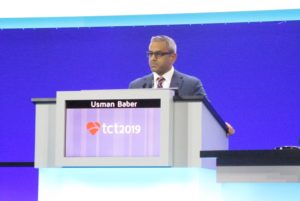
Data from the TWILIGHT study demonstrate that, compared to ticagrelor plus aspirin, ticagrelor monotherapy reduces bleeding events without increasing the risk of death, myocardial infarction, or stroke in high-risk patients who have undergone successful percutaneous coronary intervention (PCI) and completed three months of dual antiplatelet therapy (DAPT).
Roxana Mehran (Mount Sinai School of Medicine, New York, USA) reported the findings today at the Transcatheter Cardiovascular Therapeutics scientific symposium (TCT 2019; 25–29 September, San Francisco, USA). The study was also simultaneously published in the New England Journal of Medicine (NEJM).
TWILIGHT was a randomised, placebo-controlled trial, conducted between July 2015 and December 2017; it enrolled 9,006 patients whom the treating clinician intended to discharge on ticagrelor plus aspirin following successful PCI with at least one locally approved drug-eluting stent. Further inclusion criteria were the presence of at least one clinical and one angiographic feature associated with a high risk of ischaemic or bleeding events.
After completing three months of DAPT, event-free patients were randomised to aspirin or placebo with continuation of ticagrelor for an additional 12 months. A total of 7,119 patients were randomised at 187 sites in 11 countries (23.8% female, 36.8% diabetes mellitus, 64.8% acute coronary syndrome [ACS]). The primary endpoint was Bleeding Academic Research Consortium (BARC) type 2, 3, or 5 bleeding. The secondary endpoint was the composite of all-cause death, myocardial infarction, or stroke.
At one year, the incidence of major bleeding was 4% for patients randomised to ticagrelor plus placebo, and 7.1% among patients who received ticagrelor plus aspirin (hazard ratio [HR] 0.56, 95% confidence interval [CI] 0.45–0.68. p<0.001). The relative risk reduction was similar for BARC 3 or 5 bleeding (1% vs. 2%; HR 0.49, 95% CI 0.33–0.74). In addition, rates of all cause death, myocardial infarction, or stroke were 3.9% for both groups (HR 0.99, 95% CI 0.78–1.25, p noninferiority <0.001). The respective rates of all-cause death (1% vs. 1.3%), myocardial infarction (2.7% vs. 2.7%) and definite or probable stent thrombosis (0.4% vs. 0.6%) were similar between groups. There were 16 ischaemic strokes in the ticagrelor monotherapy group and eight ischaemic strokes in the DAPT group (0.5% vs. 0.2%). The effect of ticagrelor monotherapy on the key secondary outcome was consistent across predefined subgroups.
Mehran told the conference: “We met our primary endpoint – in fact, looking at BARC 3 and 5 bleeding we observed a significant reduction of bleeding … and looking across all prespecified bleeding endpoints … we showed exactly the same reduction with a significant reduction of peeling away aspirin.”
On secondary endpoints, she said: “When you look at the components of the composite they were similar across all-cause mortality, MI, stroke and stent thrombosis.” However, she cautioned: “These results are not generalisable to all patients undergoing PCI; we had important inclusion and exclusion criteria. And they are not generalisable for patients receiving background therapy with other P2Y12 inhibitors.”
Writing in the NEJM, the investigators conclude: “Our trial showed that in high-risk patients who had undergone PCI and were treated with ticagrelor and aspirin for three months, an antiplatelet strategy of continuing ticagrelor alone resulted in substantially less bleeding than ticagrelor plus aspirin, without leading to ischaemic harm over a period of one year.”

In a later session, Usman Baber (Mount Sinai School of Medicine, New York, USA) presented the findings of a TWILIGHT Thrombogenicity substudy which corroborates the clinical observations of no incremental ischaemic risk upon aspirin withdrawal. The mechanistic-oriented substudy was nested within TWILIGHT and conducted at a single enrolling site (Mount Sinai Hospital, New York, USA). Participants were enrolled after randomisation in the main trial, at which point pharmacodynamics studies to establish baseline levels of blood thrombogenicity were performed. Patients then commenced randomised therapy and returned every one to six months thereafter for repeat studies. The primary endpoint was blood thrombogenicity (platelet-dependent thrombus area) at the post-randomisation visit. The secondary endpoints were platelet reactivity in whole blood measured with impedance aggregometry, and agonists that included adenosine diphosphate, arachidonic acid, collagen and thrombin receptor activator peptide-6.
The investigators found that ticagrelor monotherapy provides a similar antithrombotic effect to that of ticagrelor plus aspirin as assessed by ex-vivo platelet-dependent thrombus formation, and that platelet reactivity to collagen and arachidonic acid is increased in the absence of aspirin, while aggregation to adenosine diphosphate and thrombin is unchanged with or without aspirin.
Baber told Cardiovascular News: “As an academic, investigator-initiated global trial, this effort represents the concerted and enthusiastic support of partners and collaborators within the USA and abroad who were committed to answering an important and clinically relevant question. The overall magnitude and consistency of effect we observed with ticagrelor monotherapy suggests this may be a safer and effective antiplatelet strategy as compared with standard of care.”










